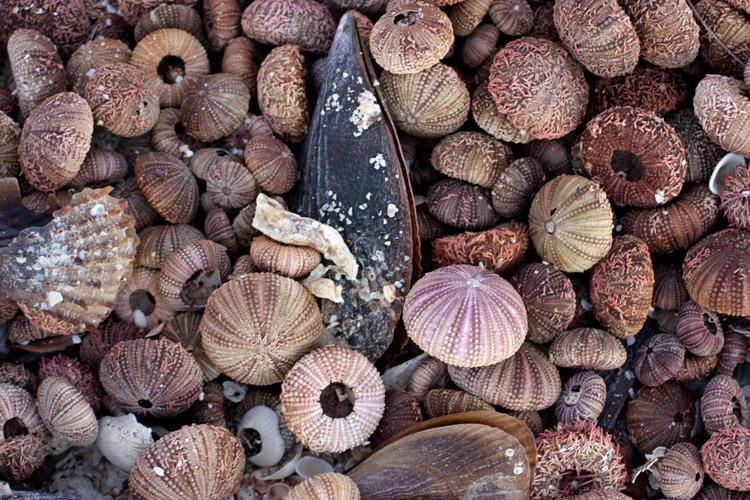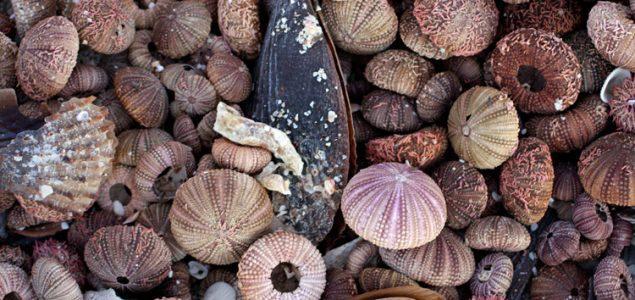A few years ago I started building a photo album I labeled “Patterns.” It soon grew to five hundred photos, making me realize that it’s not just the way I SEE nature it’s the way nature IS.
I can hardly step outdoors without noticing patterns everywhere: ripples in a puddle, the matching designs in butterfly wings, a mackerel sky which forecasts rain. Repetitive branching habits of cypress show up in winter after the trees drop their needles. All four wings of a dragonfly repeat a similar intricate design. So do bird feathers—from the simple—picture the catbird in Quaker gray– to the elaborate — a wood duck clothed in a kaleidoscope of color. A pattern will define a species of snake like the diamondback rattlesnake.
In the piney woods, clouds form the backdrop but the trees take precedence. Beautifully balanced, the pines attain a perfection of trunks, branches and twigs all working together to form a repetitive pattern. The whole is repeated in the details. At the end of a stressful day, they are calming—and beautiful to behold.
Remember the 20th century artist Jackson Pollack who dribbled paint all over huge canvasses? Critics dubbed him “Jack the Dripper” but now scientists have affirmed his unique artistry telling us there is order in all those messy paint splatters. They also have found that perceiving patterns (which they call fractals) in Pollack’s and other artist’s work is calming, just like the pines.
What is a fractal? The Fractal Institute defines it as “a never ending pattern that repeats itself at different scales.”
Richard Taylor, Professor of Physics, Psychology and Art at the University of Oregon’s Material Science Institute has made the study of fractals his life work.” He’s documenting what happens in the brain when we look at fractals. Along with other researchers, he has studied the art of Jackson Pollack and found that what are first taken to be random, chaotic drips of color are in reality highly ordered creations. Pleasing to observers, Pollack’s paintings command some of the highest prices in the art market.
Taylor’s research marries science and art, a startling departure from the norm. Perhaps they’re keeping mum about it but I can count on one hand the number of times I’ve come across scientists incorporating art into their work.
It wasn’t always that way. Centuries ago, Leonardo da Vinci routinely combined art and science in his life work. Each infused the other. In mathematical precision, “The Last Supper” was laid out in one point perspective, a radical departure from the norm. The Mona Lisa smile resulted from his observations while dissecting human cadavers. The wings of a dragonfly inspired his invention of a helicopter.
Nature is full of fractals—everything from seashells on the beach to hurricane skies. Repetitive decorative designs are everywhere, (picture lopsided Indian grass, seeds on the back of ferns and lichen on a tree trunk). Seemingly chaotic landscapes, such as woodlands, beaches and desert-like scrub, all incorporate a kind of internal organization.
Patterns in the Florida landscape change with the seasons. Summer is verdant opulence with dense curving shapes; the winter landscape is pared down to line, light and shadow in tawny muted colors. Both convey the diversity and the richness of the peninsula.
Summer skies are a never-ending progression of patterns. Early in the day hundreds of little puffs of smoke (cumulus) grow into dozens of towering thunderheads (cumulonimbus) in late afternoon which dot the horizon at sundown, nature’s artistry of the highest order.
I’ve noticed that animal behavior is repetitive. The squirrel leaping from branch to branch in “my” pines takes the same route on a daily basis just as the rabbit emerging from her burrow follows a proscribed route feeding on grasses and flowers along the edge of the woods. As I’m eating lunch, (I, too, stick to a schedule) a gopher tortoise—most likely the same one—walks the sandy road feeding on wildflowers. With beating hearts and blinking eyes, repetition is programmed into us humans and the creatures around us.
At the beach, endlessly varied and invariably beautiful shells fit into a coherent whole. Attracted by a school of fish, terns take off in synchronized flight, each bird equidistant from the other. As I photograph them, I’m thinking, “This would make great wallpaper!” In the dark of night, a loggerhead sea turtle climbs onto a beach to lay her eggs in the place where she was hatched. The next morning, Mote Marine Lab volunteers follow her labored tracks up to the fore dunes to mark the spot.
The sound of waves breaking on the shore– twelve to the minute in the Gulf of Mexico—is another aspect of the beach scene. In my yard, a cardinal singing in spring elicits a similar reply off in the distance, like an audio tennis match. When the great horned owl hoots at night, it’s never one hoot but a rhythmic sequence of hoots. Bobwhite calls his name not once but three times, over and over again.
Without even thinking about it, we humans incorporate the concept of fractals into our work making order out of chaos. It is difficult to think of a trade that does not incorporate patterns. Imagine your bathroom tile in some willy-nilly arrangement. Look at a multi-storied building under construction and you’ll see the regular placement of drywall, insulation, electrical, plumbing. Roofing is perhaps the most obvious. So is landscaping, but gardeners who equate beauty with order can carry that to extremes in a weed-free lawn. Devoid of life, the lawn does no good to anyone, especially wildlife (except for fire ants).
“Perhaps it is human nature to seek patterns.“ Jay Withgott wrote in his article “So Long Linnaeus”? They rule the world—and our lives. Understanding natural cycles helped us survive early on. In an orderly unfolding of our planetary year, we could count on the same times of sunrise and sunset as our planet followed its proscribed orbit around the sun.
The patterns we see in nature are soothing. They feed our souls. Hopefully they inspire us to take care of the planet.

